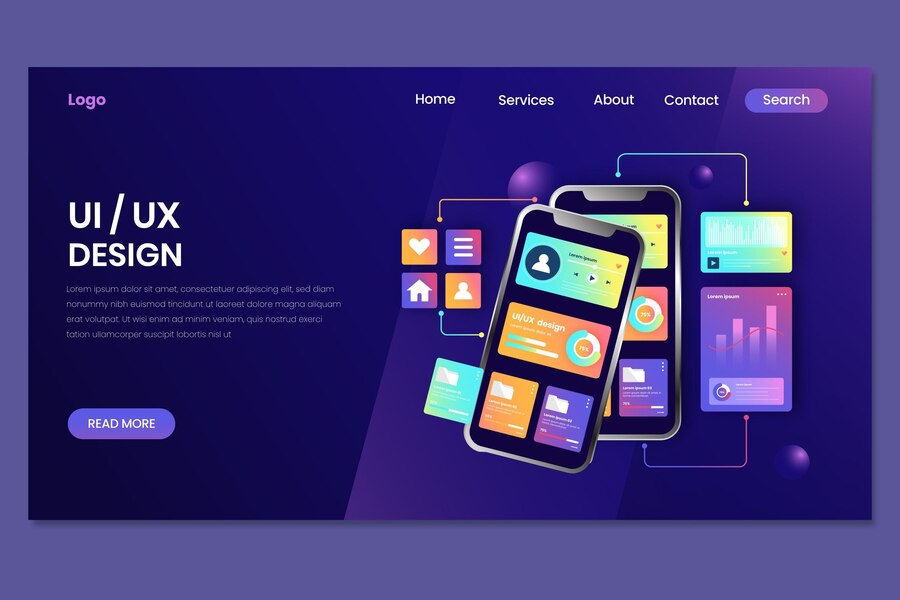Mobile-First Design: Ensuring a Seamless Cross-Device Experience

With mobile devices accounting for over 60% of global web traffic, mobile-first design has become essential for ensuring a seamless user experience across different devices. A mobile-first approach prioritizes designing for small screens first, then scaling up for larger screens, ensuring usability, performance, and accessibility.
A restaurant’s website struggled with low mobile reservations due to a non-responsive design and poor mobile usability. After implementing a mobile-first redesign, which included adaptive grid layouts and touch-friendly UI elements, mobile reservations increased significantly.
This article explores why mobile-first design is critical, how adaptive layouts improve responsiveness, and how touch-friendly elements enhance mobile usability.

Case Study: A Restaurant’s Website Increased Mobile Reservations After a Responsive Redesign
A fine-dining restaurant noticed that:
-
Over 70% of visitors accessed the website via mobile, but reservation rates were low.
-
Users struggled to navigate the menu and book a table due to small, hard-to-click buttons.
-
The website loaded slowly on mobile, frustrating users.
UX/UI Changes Implemented
To enhance mobile usability, the UX/UI team:
-
Redesigned the website with a mobile-first approach, prioritizing fast load times and clean navigation.
-
Used an adaptive grid layout to ensure content scaled seamlessly across devices.
-
Implemented large, touch-friendly buttons for easier reservations.
Results:
-
Mobile reservations increased by 45%.
-
Bounce rates on mobile dropped by 30%.
-
Page load time improved by 40%.
Why Mobile-First Design is Critical in Modern UX/UI
Shifting User Behavior
Users now expect fast, intuitive, and mobile-friendly experiences. If a website doesn’t function well on mobile, users will leave.
SEO and Mobile-First Indexing
-
Google prioritizes mobile-friendly websites in search rankings.
-
Websites that aren’t optimized for mobile lose organic traffic.
Improved User Engagement
-
Mobile-first design improves usability, keeping users engaged longer.
-
Ensuring fast load speeds reduces frustration and bounce rates.
Using Adaptive and Fluid Grid Layouts for Better Responsiveness
What Are Adaptive and Fluid Grid Layouts?
-
Adaptive Layouts: Use breakpoints to adjust design elements at different screen sizes.
-
Fluid Layouts: Scale elements dynamically based on percentage widths, ensuring content looks good on all screen sizes.
Best Practices for Responsive Layouts
-
Design for Mobile First, Then Scale Up
-
Start with a simple, minimal mobile layout.
-
Gradually enhance elements for larger screens.
-
Use a Flexible Grid System
-
CSS Grid and Flexbox help ensure adaptive layouts.
-
Keep spacing consistent across screen sizes.
-
Optimize Image and Text Scaling
-
Use responsive image sizing (srcset) for different screen resolutions.
-
Ensure text remains legible across screen sizes.
Example from the Restaurant Case Study:
-
The menu was redesigned with a fluid grid, making it easier to browse on different screen sizes.
-
Font sizes and images scaled proportionally, ensuring readability.
-
Result: Mobile users could navigate effortlessly, leading to higher engagement and more reservations.
Implementing Touch-Friendly UI Elements for Mobile Users
Challenges of Traditional UI on Mobile
-
Small buttons cause misclicks.
-
Dropdown menus can be hard to tap.
-
Forms can be frustrating without autofill options.
How to Improve Mobile UI
-
Use Large, Tap-Friendly Buttons
-
Buttons should be at least 48x48 pixels for easy tapping.
-
Ensure adequate spacing between interactive elements.
-
Implement Thumb-Friendly Navigation
-
Design for one-handed use, placing key elements within the thumb zone.
-
Keep primary actions at the bottom of the screen for easier access.
-
Simplify Forms for Mobile Input
-
Use auto-fill and predictive text to reduce typing.
-
Provide drop-down selections and toggle buttons instead of text fields.
Example from the Restaurant Case Study:
-
The reservation button was enlarged and moved to the homepage for quick access.
-
A one-tap booking system replaced a lengthy form.
-
Result: Reservations via mobile increased significantly.
Summary: How Mobile-First Design Enhances UX/UI
Key Takeaways:
-
Mobile-first design improves user engagement by ensuring fast load times and intuitive navigation.
-
Adaptive and fluid layouts make websites responsive across all screen sizes.
-
Touch-friendly UI elements enhance usability, preventing misclicks and reducing friction.
Conclusion
A well-executed mobile-first design creates seamless, user-friendly experiences across devices. Businesses that prioritize fast, adaptive, and touch-friendly interfaces will retain more users and improve conversions.
By implementing mobile-first UX/UI strategies, companies can stay competitive and provide better experiences for modern digital users.


Subscribe to follow product news, latest in technology, solutions, and updates
Other articles for you



Let’s build digital products that are simply awesome !
We will get back to you within 24 hours!Go to contact us Please tell us your ideas.
Please tell us your ideas.







